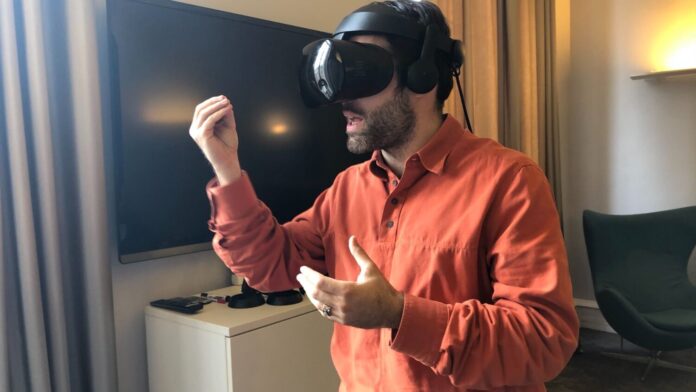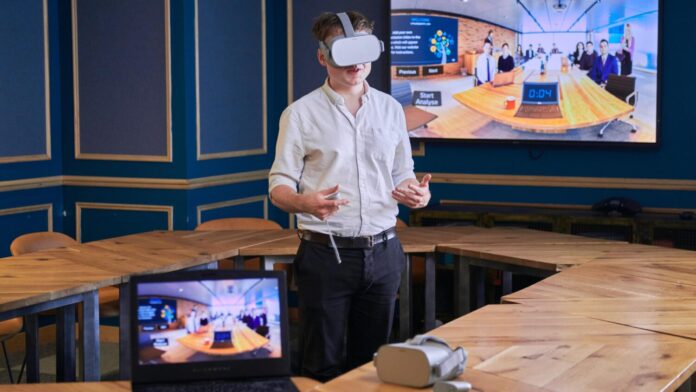
From the oratories of ancient Greek philosophers to the passionate discourses of the Renaissance and the eloquent declarations of the 20th century, speech writing has undergone a profound transformation.
Once a craft honed with quill and parchment, its deliverance lay in the power of words alone.Today, the art of composing speeches is not just about stringing together impactful words but also about how these words are delivered and consumed in an era dominated by screens, digital media, and real-time connectivity.
This article looks into the nuances of modern speech writing, highlighting the integration of multimedia elements and the revolutionary impact of virtual reality on public speaking. In an age where technology reigns supreme, the success of a speech hinges not just on its content, but also on its mode of delivery and the experience it offers to its audience.
Incorporating Multimedia Elements in Speech Writing

Incorporating multimedia elements in speech writing has become an indispensable strategy for a speech writer in today’s age of fleeting attention spans and the demand for dynamic content.
Historically, speeches were primarily about the rhetoric, the cadence, and the eloquence of the speaker’s words. For instance, Martin Luther King Jr.’s “I Have a Dream” speech was delivered on the steps of the Lincoln Memorial without the aid of flashy visuals or digital enhancements, yet it held the audience spellbound with its profound message and eloquent delivery.
As we transitioned into the 21st century, the landscape of public speaking underwent a radical shift. With platforms like TED Talks leading the way, speeches began incorporating visual aids, animations, and even short video clips to accentuate their message.
A notable example is Hans Rosling, and his 2006 TED Talk, “The Best Stats You’ve Ever Seen“, where he brilliantly used data visualization to debunk myths about the developing world.
The multimedia elements didn’t distract from Rosling’s message but rather amplified it, making complex statistics more understandable and engaging for the audience.
Benefits of Multimedia in Speeches
Enhancing Understanding Through Visuals

As the old adage goes, “A picture is worth a thousand words.” Graphs, diagrams, and images can elucidate intricate concepts that might take lengthy explanations if solely relying on words.
For instance, a speaker discussing climate change can utilize graphical data to depict rising global temperatures over the decades, providing a clear and immediate understanding of the issue at hand.
Captivating the Audience
Capturing and retaining an audience’s attention can be a herculean task. Multimedia acts as an anchor, ensuring that listeners remain engrossed.
A dynamic PowerPoint presentation, a short film clip, or even an interactive poll can break the monotony of a prolonged speech, keeping the audience’s focus riveted.
Emotional Connection
Music, poignant images, and evocative videos can amplify the emotional resonance of a speaker’s words.
A speech about wildlife conservation, complemented by footage of majestic animals in their natural habitats or heart-wrenching images of endangered species, can stir emotions, motivating listeners to take action in ways that words alone might not achieve.
Tips for Integrating Multimedia Elements Effectively

It’s imperative to understand your audience and their preferences. A tech-savvy crowd might appreciate augmented reality elements, while a more traditional audience might resonate with simpler visual aids.
Balance textual content with multimedia. Overloading a presentation with flashy animations or videos can distract from the speech’s central message, turning what should be an aid into an obstacle.
This leads to the third cardinal rule: relevancy. Every multimedia element should serve a clear purpose, complementing and reinforcing the core message of the speech.
It’s not about using technology for its own sake, but about enhancing communication and driving home the message in the most impactful manner.
Virtual Reality (VR) and the Future of Public Speaking

Virtual Reality (VR) represents a groundbreaking shift in the realms of technology and interactive experience, transporting users into immersive, three-dimensional digital environments.
Instead of delivering speeches on physical stages, speakers can now address global audiences from virtual platforms, creating bespoke environments tailored to the theme of their discourse.
Imagine a historian discussing ancient Rome while virtually walking the audience through a lifelike reconstruction of the Colosseum, or a marine biologist explaining coral degradation while floating through a simulated vibrant reef.
With VR, the boundaries of public speaking are being expanded, offering a multisensory experience that traditional platforms could never achieve.
Advantages of VR in Public Speaking

Its capacity to create immersive environments means that audiences aren’t just passive listeners; they’re virtually transported into curated worlds that amplify the speech’s content, be it a simulated journey through space or a deep dive into the human body’s cellular structure. VR caters to personalization like no other medium.
Depending on their preferences, audience members can choose different viewing angles, focus on specific aspects of the presentation, or even interact with the virtual elements, ensuring a unique experience for each individual. Perhaps the most revolutionary advantage is the erasure of geographical limitations.
With VR, a speaker stationed in New York can seamlessly address an audience that spans from Tokyo to Johannesburg, creating a global conversation devoid of borders and bridging cultural divides.
Role of Speechwriting in VR Era
Interactivity ushers in new frontiers of audience engagement. Instead of a monologue, VR-enabled speeches might incorporate real-time feedback, audience-directed exploration, or branching pathways in the discourse, demanding adaptability from the speaker.
Orators for this dynamic realm aren’t just conveying a message; they’re orchestrating an immersive experience.
As we stand at the confluence of tradition and technology, it’s evident that speech writing and public speaking are undergoing a transformative evolution. Incorporating multimedia elements and harnessing the immersive potential of VR are not just trends, but vital tools for effective communication in this digital age.
Embracing these advancements, while staying rooted in the timeless principles of impactful oration, will shape the future of public discourse, making it more engaging, accessible, and profound than ever before.
For a successful conference, public speech, and gathering, you must choose the right speaker for your audience. Fortunately, we wrote an article about the differences between keynote speakers and guest speakers to aid you in deciding which one could be of use for you.








